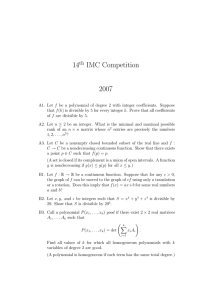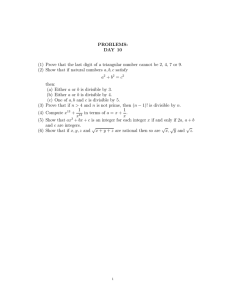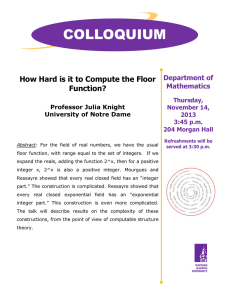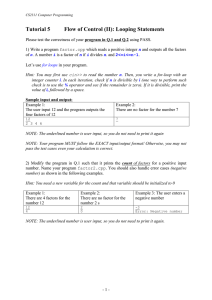Document 13661327
advertisement
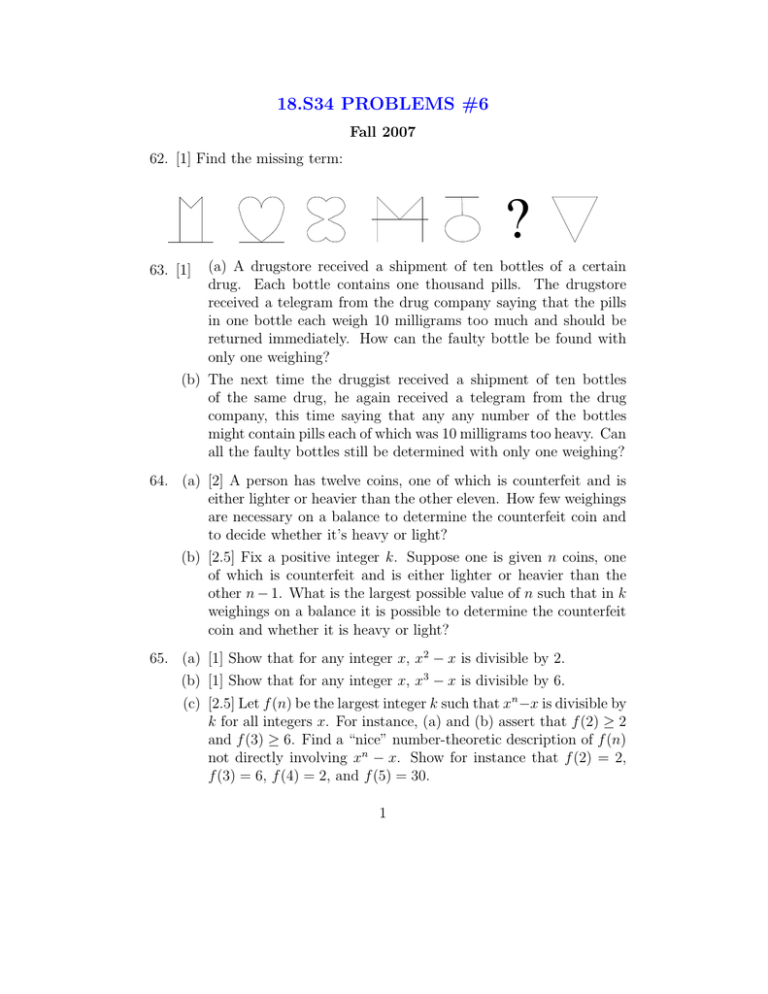
18.S34 PROBLEMS #6 Fall 2007 62. [1] Find the missing term: ? 63. [1] (a) A drugstore received a shipment of ten bottles of a certain drug. Each bottle contains one thousand pills. The drugstore received a telegram from the drug company saying that the pills in one bottle each weigh 10 milligrams too much and should be returned immediately. How can the faulty bottle be found with only one weighing? (b) The next time the druggist received a shipment of ten bottles of the same drug, he again received a telegram from the drug company, this time saying that any any number of the bottles might contain pills each of which was 10 milligrams too heavy. Can all the faulty bottles still be determined with only one weighing? 64. (a) [2] A person has twelve coins, one of which is counterfeit and is either lighter or heavier than the other eleven. How few weighings are necessary on a balance to determine the counterfeit coin and to decide whether it’s heavy or light? (b) [2.5] Fix a positive integer k. Suppose one is given n coins, one of which is counterfeit and is either lighter or heavier than the other n − 1. What is the largest possible value of n such that in k weighings on a balance it is possible to determine the counterfeit coin and whether it is heavy or light? 65. (a) [1] Show that for any integer x, x2 − x is divisible by 2. (b) [1] Show that for any integer x, x3 − x is divisible by 6. (c) [2.5] Let f (n) be the largest integer k such that xn −x is divisible by k for all integers x. For instance, (a) and (b) assert that f (2) � 2 and f (3) � 6. Find a “nice” number-theoretic description of f (n) not directly involving xn − x. Show for instance that f (2) = 2, f (3) = 6, f (4) = 2, and f (5) = 30. 1 66. [1] (a) A person starts at the point x = 1 ft. at time t = 0 sec. and moves along the x-axis so that his velocity in feet per second is equal to his distance in feet from x = 0. (So in particular at time ft .) Where will he be in one second? t = 0 his velocity is 1 sec ft when his/her distance from x = 0 is (b) What if his velocity is x2 sec x ft? 67. [2] Let P (x) be a polynomial of degree n satisfying P (i) = 2i if 0 � i � n. What is P (n + 1)? 68. [2] Let n be an integer greater than one. Show that n4 + 4n is not prime. 69. [2] Erect a square (facing outwards) on each side of a convex quadri­ lateral. Join the centers of each pair of opposite squares by a straight line. Show that these two straight lines intersect in right angles. 2 70. [2] Let h(n) be the number of regions formed inside a circle by choosing n points on the circumference and drawing a straight line segment between every two of the points. Assume the points have been chosen so that no three of these chords intersect in a single point in the interior of the circle. For instance, h(4) = 8: 1 4 2 3 6 7 8 5 Find a simple formula for h(n). 71. [2] A man and a fly both start out at the point x = 0 at time t = 0. The man walks 4 mi/hr in the positive x-direction. The fly flies at a rate of 10 mi/hr. It continually flies between the man and the point x = 0. Where will the fly be after one hour? (Do not confuse this problem with a similar one where a fly flies between two trains moving toward each other.) 72. [5] Show that 462 is the largest integer that cannot be written in the form ab + ac + bc, where a, b, c are positive integers. (It is known that there is at most one more such integer n. If it exists, then it satisfies n > 2 · 1011 .) 73. [3] Does there exist an infinite binary word w = a1 a2 · · · (ai = 0 or 1) that is not eventually periodic, such that for all n sufficiently large, 3 the prefix a1 a2 · · · an ends in a (nonempty) square, i.e., we can write a1 a2 · · · an = xy 2 (concatenation of words) with y nonempty? 4

